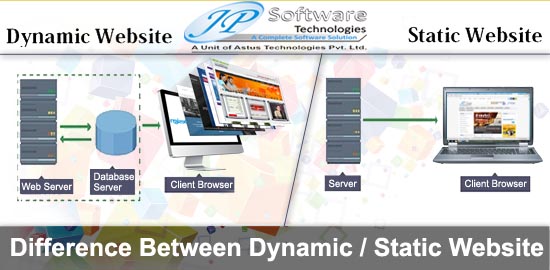Dynamic website
A dynamic website is a site whose content can be dynamically generated, meaning that content is displayed according to the user who accesses or other parameters. Dynamic web sites are created in languages more complex than static websites and include the use of databases, which offer more development opportunities for a static website.
The advantages of a dynamic website
- The updates do not require specific IT knowledge and can be performed in the house: no risk of dependence vis-à-vis a webmaster.
- Dynamic web sites are scalable: they can graft a variety of modules. They allow almost unlimited capabilities in terms of interactivity: newsletters, calendars, online payments, forums,
- The cost of developing a dynamic site is higher than a static site. However, updates are performed within the company, the savings quickly take precedence over the basic investment.
- Restructuring of dynamic websites is easier, thus ensuring its longevity
- Can be developed/amended/added to as and when required
- Access to be able to content manage the website from any computer, anywhere in the world (that has an Internet connection)
- Website content contributors/editors only need basic content editing skills
- Multiple user access for updating/content managing – Users or employees who are ‘experts’ in their subject area can add information to their relevant section of the website. The amount of access can also be setup.
- A Dynamic Website allows you to archive past material on a certain date or allows an item to be published or removed at a certain date automatically.
- As the content is held within a database it allows the user to search the database for content, also a site map is automatically generated as content is added.
Why opting for a dynamic website?
A dynamic website is an ideal solution for companies wishing to post the majority of its products and services. The multitude of options and tools available offers unlimited opportunities for development, tailored to the needs of the business. The update in-house allows complete control and instantaneous evolution of the site.
A Dynamic Website has an interface that is entirely separate from the content which is presented within it. This has the effect of making the structure of the website and also the appearance extremely adaptable. In the case of a static website, when you click a link you are presented with the interface and text in one. In the case of a dynamic website, the interface design is constant and the text is pulled from a database on demand i.e. when you click a button or link.
A dynamic website for your business
You want to give your business a dynamic website? Web Solution Way can provide you the solution best suited to your type of business, your product or philosophy. Contact us via our form.
Additional features available by implementing a dynamic website:
By constructing the website with dynamic capabilities it opens up a wide range of possibilities such as:
- Online booking
- E-Newsletter (subscription and distribution)
- Online photo galleries
- E-commerce
- Voting/Polls
- Forums/Message Boards
Static Website
A Static website can be defined as follows:
This generally refers to elements of the Internet or computer programming that are fixed and not capable of action or change. A Website that is static can only supply information that is written into the HTML and this information will not change unless the change is written into the source code. When a Web browser requests the specific static Web page, a server returns the page to the browser and the user only gets whatever information is contained in the HTML code. In practice, this results in the delivery of the interface, images, and text as one item. In contrast, a dynamic Web page contains content that a user can interact with, such as information that is tied to a database, therefore the interface and structure of the site can be manipulated independently of the content.
What are the advantages and disadvantages of having a static website?
Advantages
- Generally cheaper to implement on a smaller scale if fewer pages are required
- Good for smaller companies as there is no need for any management system; it is the responsibility of one person
Disadvantages
- More expensive to maintain in the long term if updates are more frequent. This is because any changes have to be made to pages individually. For example, if you had a menu item that appeared on every page that required amending, each individual page throughout the site would have to be updated.
- Not updatable by the Client, thus relying on the Web designer to edit.
- Increased risk to the business, as the person with web skills, could fall ill or leave, meaning that the website can no longer be maintained without complications.
- Management is restricted to one machine. If changes need to be made then this is only possible where the editing tool is installed.
- Website editors need significant training and skills to develop the website to modern-day standards and practices. This is time-consuming, expensive and ongoing.
Summary
Many sites from the last decade are static, but more and more people are realizing the advantages of having a dynamic website. Dynamic websites can make the most of your site and either uses it as a tool or create a professional, interesting experience for your visitors.

